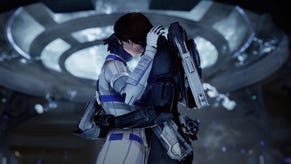Mass Effect PS3 demo vs. final code
Has final game been improved?
The only taste of Mass Effect 2 on PlayStation 3 that gamers have had so far is a demo that we took a look at before breaking off for the Christmas holiday. Our first thoughts? Aside from an unlocked frame-rate and lighting variations, it was much the same as the Xbox 360 version.
On 13th January, BioWare's community man Chris Priestly, posting on the PlayStation Blog, revealed that "the demo was, for certification and testing reasons, about a two-month-older build than the final 'what you will play when you get it home' version. I think you'll see that the game is noticeably better at launch."
Previous claims that the PS3 version would be the "definitive" version of the game didn't stack up based on the demo code, so the question remains: how does the final game stack up? We're covering the PS3 vs. Xbox 360 side of things in our Mass Effect 2 Face-Off, but here we'll be comparing the demo experience with the final game.
There is no doubt whatsoever that many significant changes have been made. For starters, let's take a look at the performance aspect. The Xbox 360 game operated with v-sync, eliminating tearing and ensuring visual consistency in the highly detailed artwork. However, the downside of this was that when the frame-rate dropped beneath 30FPS it caused a sustained drop to 20FPS, because the GPU effectively stalled, waiting to start rendering the next frame.
In the PS3 demo, BioWare not only disabled v-sync, but also appeared to run with an uncapped frame-rate. Many of the drops to 20FPS in the Xbox 360 code were gone, but with a modicum of screen-tear in its place. Gameplay was affected more significantly, with a very variable frame-rate, this having been capped at 30FPS on Xbox 360.
So let's compare performance from the demo and see what's happened in the retail version of the game.
This is an example of how parity has been restored to the two versions of the game. The v-sync implementation has been re-enabled, so PS3 Mass Effect 2 now matches the Xbox 360 game. Additionally, the 30FPS frame-rate cap has also been reinstalled.
This has had two effects. First, the tearing and jitter added to the gameplay experience in the PS3 version is now gone - and this is a move for the better in our view. Second, and perhaps less welcome, is that the frame-rate drops we saw on 360 - 30FPS suddenly down to 20FPS, especially evident in the cut-scenes – are now back. This was the demo code's one real advantage over the 360 game, and as the Face-Off shows, the higher average frame-rate we saw is now a thing of the past.
There are many other changes between the demo and review code. For a start, the jerky, tearing FMVs are gone; they now work as they should. A number of other bugs have been corrected too - Joker's temporarily disappearing head in his first cut-scene has been fixed, for example. The occasionally dodgy lighting also appears to have had corrections in places, too, though there are still many differences in this regard between the PS3 version and the existing PC and 360 SKUs.
Overall then, BioWare was right to say that the sampler code is old, and an unlocked frame-rate was either a bold experiment or simply an oversight, although it's hard to think of any other reason to explain bugs such as Joker's disappearing head. These have all been fixed for the final game, ensuring a closer degree of parity with existing versions.









